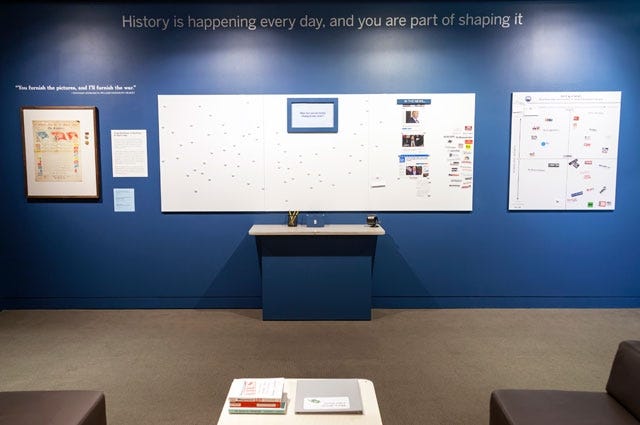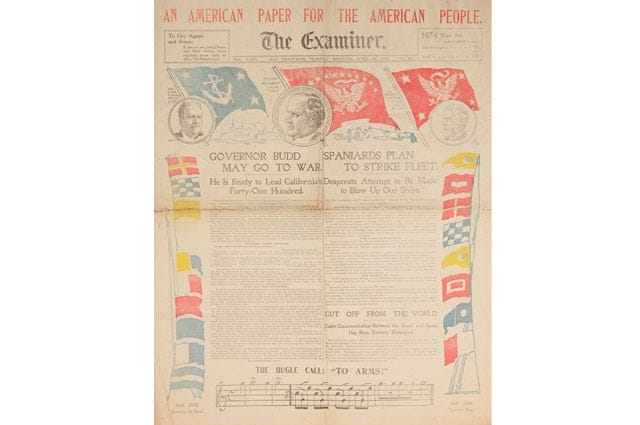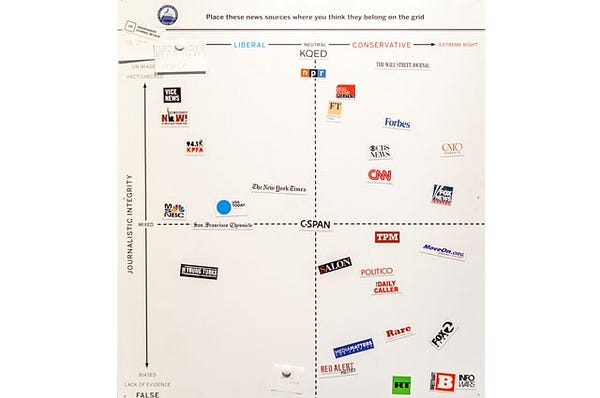
Latest “History Now” exhibit explores history of yellow journalism
By Nicole Lovett
Fake news is generally thought to be a new topic brought about by President Donald Trump, but the latest History Now exhibit at the Oakland Museum of California reminds us that fake news has always been prevalent in history. Curated by OMCA Curator of Photography and Visual Culture, this exhibit fits a big topic very efficiently into a small space.
Upon first glance, the exhibit seems underwhelming and a little out of place. It is confined to a small portion of the gallery and doesn’t match the aesthetic of the rest of the Gallery of California History, which focuses mostly on the history of peoples rather than the media.
With the advent of social media, we as citizens have the power to make the history of the future.
—
Beneath the words “History is happening everyday, and you are a part of shaping it” on the west wall of the exhibit hangs a newspaper reproduction in bright colors and two white boards. Before viewing this exhibit, the connection between California History and fake news may not be clear, but this display answers the question of why this exhibit belongs in a gallery of California History.

A reproduction of an 1898 issue of the San Francisco Examiner reads: “Governor Budd may go to war. Spaniards plan to Strike Fleet.” This headline was one of many that helped prompt war between the United States and Spain. In short: fake news created an urgent terror, and California was a part of it.
William Randolph Hearst was the publisher of the Examiner along with other publications that strove to sell papers by sensationalizing and conjuring up false news events called “yellow journalism.”
Next to the newspaper reproduction is a magnetic whiteboard where museum attendees can answer the question: “How has social media changed our news?” Visitors can take a notecard and display their opinion anonymously.

The board next to it is a magnetic four-grid graph with different magnets of various news sources finding their place–the upper left corner of the graph is “truthful and liberal” while the lower right is “conservative,” with “lack of evidence.”
Visitors are invited to place different news sources on the graph based on where they think their journalistic integrity and neutrality lies.
“It has happened before. It could happen again.”
—
To the north wall of the exhibit is a mock front page newspaper called “The Fake News.” Underneath the title, the newspaper warns: “It has happened before. It could happen again.”
The mock front page is reminiscent of the war that Hearst helped start with his yellow journalism. There are also highlighted tweets from President Trump attacking the news media. The first featured tweet reads: “The FAKE NEWS media…is not my enemy, it is the enemy of the American People!”
An old University of California Berkeley poster on the west wall of the exhibit further emphasizes that the subject of unreliable news is not exclusive to 2017, and not a stranger to our state. “Is the Media Failing America?” the 2006 poster asks, advertising a talk with a former CBS news anchor.
“The FAKE NEWS media…is not my enemy, it is the enemy of the American People!”
— Tweet written by POTUS Donald Trump
Finally, within the center of the Fake News exhibit are three contemporary books that tackle how to think critically about news and how to step outside of a biased bubble. Three quaint couches are available as a space to read. Although the exhibit physically takes up a small portion of the museum, a person could spend hours in that portion.
Overall, the Fake News exhibit did an excellent job of getting its points across: fake news has always been present in society, California has always been a part of that story and, with the advent of social media, we as citizens have the power to make the history of the future.
Nicole Lovett is a Tower Staff Writer.

























